
In botany, a bulb is structurally a short stem with fleshy leaves or leaf bases that function as food storage organs during dormancy.

Oxalis is a large genus of flowering plants in the wood-sorrel family Oxalidaceae, comprising over 550 species. The genus occurs throughout most of the world, except for the polar areas; species diversity is particularly rich in tropical Brazil, Mexico, and South Africa.
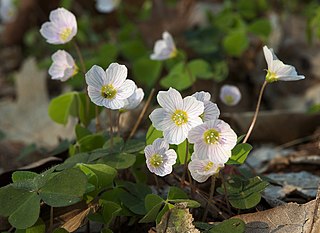
Oxalis acetosella, the wood sorrel or common wood sorrel, is a rhizomatous flowering plant in the family Oxalidaceae, common in most of Europe and parts of Asia. The specific epithet acetosella refers to its sour taste. The common name wood sorrel is often used for other plants in the genus Oxalis. In much of its range it is the only member of its genus and hence simply known as "the" wood sorrel. While common wood sorrel may be used to differentiate it from most other species of Oxalis, in North America, Oxalis montana is also called common wood sorrel. It is also known as Alleluia because it blossoms between Easter and Pentecost, when the Psalms which end with Hallelujah are sung.
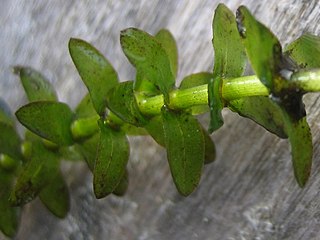
Elodea is a genus of 6 species of aquatic plants often called the waterweeds described as a genus in 1803. Classified in the frog’s-bit family (Hydrocharitaceae), Elodea is native to the Americas and is also widely used as aquarium vegetation and laboratory demonstrations of cellular activities. It lives in fresh water. An older name for this genus is Anacharis, which serves as a common name in North America.

Hydrilla (waterthyme) is a genus of aquatic plant, usually treated as containing just one species, Hydrilla verticillata, though some botanists divide it into several species. It is native to the cool and warm waters of the Old World in Asia, Africa and Australia, with a sparse, scattered distribution; in Australia from Northern Territory, Queensland, and New South Wales.

Lilium bulbiferum, common names orange lily, fire lily,Jimmy's Bane,tiger lily and St. John's Lily, is a herbaceous European lily with underground bulbs, belonging to the Liliaceae.

Allium vineale is a perennial, bulb-forming species of wild onion, native to Europe, northwestern Africa and the Middle East. The species was introduced in Australia and North America, where it has become a noxious weed.
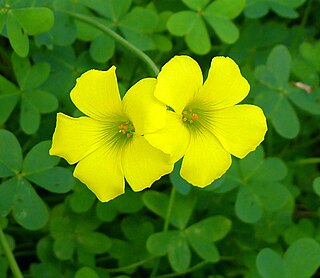
Oxalis pes-caprae is a species of tristylous yellow-flowering plant in the wood sorrel family Oxalidaceae. Oxalis cernua is a less common synonym for this species. Some of the most common names for the plant reference its sour taste owing to oxalic acid present in its tissues. Indigenous to South Africa, the plant has become a pest plant in different parts of the world that is difficult to eradicate because of how it propagates through underground bulbs.

A bulbil is a small, young plant that is reproduced vegetatively from axillary buds on the parent plant's stem or in place of a flower on an inflorescence. These young plants are clones of the parent plant that produced them—they have identical genetic material. The formation of bulbils is a form of asexual reproduction, as they can eventually go on to form new stand-alone plants.

Oxalis violacea, the violet wood-sorrel, is a perennial plant and herb in the family Oxalidaceae. It is native to the eastern and central United States.

Oxalis stricta, called the common yellow woodsorrel, common yellow oxalis, upright yellow-sorrel, lemon clover, or more ambiguously and informally "sourgrass", "sheep weed", or "pickle plant", is a herbaceous plant native to North America, parts of Eurasia, and a rare introduction in Britain. It tends to grow in woodlands, meadows, and in disturbed areas as both a perennial and annual. Erect when young, this plant later becomes decumbent as it lies down, and branches regularly. It is not to be confused with similar plants in the same genus which are also often referred to as "yellow woodsorrel".
Gastrolobium propinquum is a shrub in the family Fabaceae, endemic to the Southwest Australia savanna region, which is toxic to many animals. It has been given the common name Hutt River poison.

Oxalis triangularis, commonly called false shamrock, is a species of perennial plant in the family Oxalidaceae. It is native to several countries in southern South America. This woodsorrel is typically grown as a houseplant but can be grown outside in USDA climate zones 8a–11, preferably in light shade.
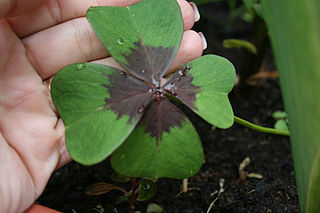
Oxalis tetraphylla is a bulbous herbaceous perennial plant from Mexico. It is sometimes sold as lucky clover or shamrock. In the wild or feral state it is often called four-leaved wood-sorrel after its family, Oxalidaceae. Other English common names for this plant include Lucky Clover, Four-Leaf Sorrel, Four-Leaf Pink-Sorrel and others. It is sometimes called "the iron cross plant" or "oxalis iron cross" because the leaves loosely resemble the iron cross symbol, though this name is not a classic folk term and has fallen out of favour due to the bad political connotations associated with this symbol.
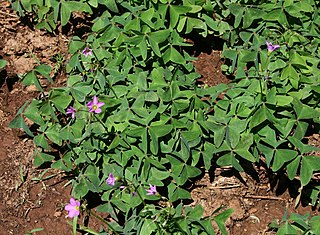
Oxalis latifolia is a species of flowering plant in the woodsorrel family known by the common names garden pink-sorrel and broadleaf woodsorrel. It is native to Mexico and parts of Central and South America.
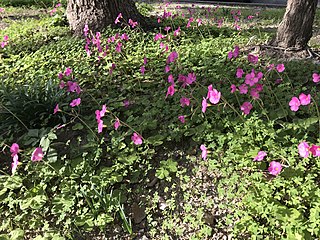
Oxalis articulata, known as pink-sorrel, pink wood sorrel, windowbox wood-sorrel, Chari amilo (Nepal),sourgrass,Netho (khatta) saag (India) is a perennial plant species in the genus Oxalis native to temperate South America. It has been introduced in Europe in gardens and is now naturalized in these areas.

Oxalis debilis, the large-flowered pink-sorrel or pink woodsorrel, is a perennial plant and herb in the family Oxalidaceae. Its original distribution is South America but has become a very cosmopolitan species, occurring in all continents except Antarctica. It can be found in both temperate and tropical areas.

Lomandra effusa is a perennial, dioecious, rhizomatous herb native to Australia. It is a perennial tussock with bluish green, large, arching leaves which are distinctive by the two toothed leaf tip. It has white, cream or pink fragrant flowers during the months of June to October.

Carpobrotus modestus, commonly known as inland pigface, is a succulent perennial of the family Aizoaceae, native to the coasts of Australia. It produces purple flowers which mature into fruits and is mainly used as a groundcover succulent or as a drought tolerant plant.
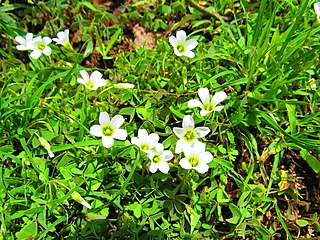
Oxalis alpina is a herbaceous perennial plant also known by its common name alpine woodsorrel. It is a species belonging to the genus Oxalis.O. alpina is found in North America and Central America from Guatemala to the southwestern United States.





















